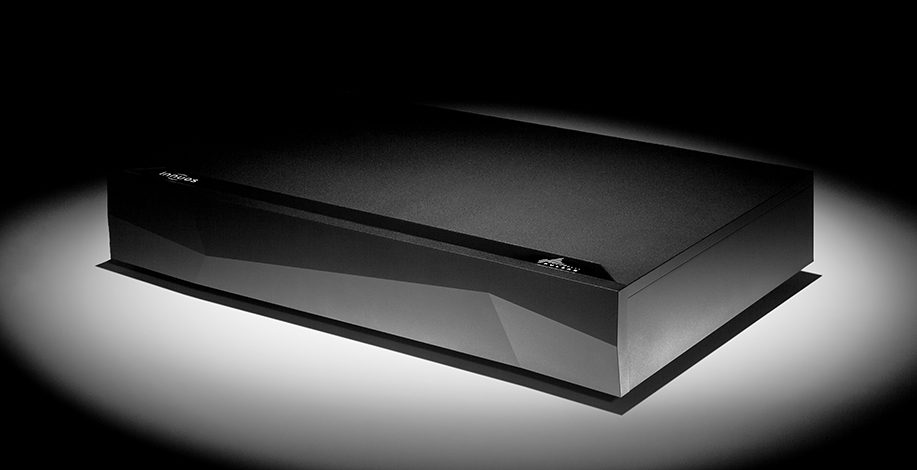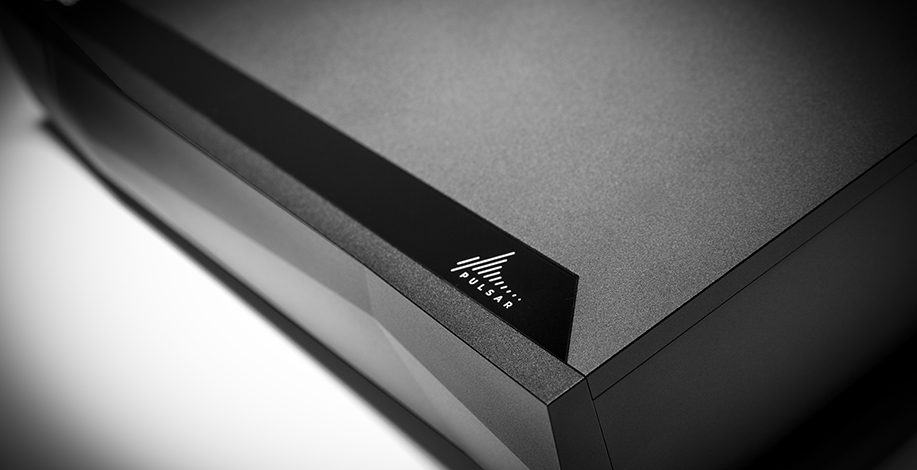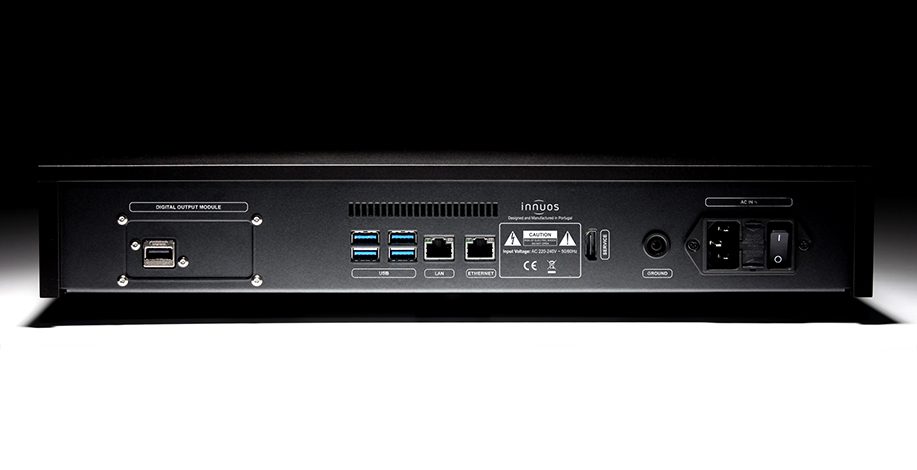
Being at the cutting edge of ripping music could be a double-edged sword for Innuos. The ZEN range and the outstanding Statement (with or without its Next-Gen power supply) make the company one of the biggest names in music servers. This is particularly true for those who rip music from CD to hard disc. Which is great… until people stop using CDs as their go-to music carrier. All the servers in the Innuos range act as extremely good streamers and high-resolution file servers. However, that little voice still says, “I’m paying for something I don’t need.” The Innuos PULSAR from the PULSE range silences that voice.
Non-Ripping Yarns
Like the ZEN series, the PULSE line of streamers and servers comprises three models; PULSEmini, PULSE and PULSAR, tested here. The ‘good, better, best’ epithets fit well. The products meet the budgetary constraints of the user, with each successive model piling on improvements over the last.
The spec sheet gets pretty packed when you get to the Innuos PULSAR. PULSAR uses Innuos’ active rectification capacitor (ARC) board, a scaled-down version of the ARC6 present on Statement NG. This is a custom module containing more than 130,000µF Mundorf capacitors. This is well met by a 300VA toroidal transformer, which goes some way to explain why a streamer weighs almost as much as a small stereo power amplifier. It’s all designed in collaboration with power supply expert Dr Sean Jacobs. The centre of this magnetically screened toroidal transformer is filled with epoxy resin.
This analogue power supply is uncommon in streamers and servers; even stepping away from essentially re-tasked computers, most server-side products use switch-mode power supplies. These might be light, cheap, plentiful and easy to implement, but if you take your server project seriously, including something that produces RFI and EMI inside the case of your source component is ‘not a good look’.
Lite, but heavy
Isolation from interference is a big thing for Innuos, and PULSAR includes a ‘Lite’ version of its PhoenixUSB reclocker (tested in Issue 184), powered by a custom regulator module. This is a replaceable Digital Output Module with Innuos working on further modules like AES/EBU and i2s. By treating noise like The Enemy (whether an invading force trying to breach the Innuos PULSAR through its connectors or the fifth column of internal power supplies), it approaches many of the performance parameters of Innuos’ Statement product. Granted, the two-box masterwork takes these concepts as far as Innuos can, but the PULSAR is a chip off the ol’ Statement block.
Even the feet are arranged asymmetrically to support the player and help dampen vibration. The strategic placement of feet sounds like the start of an exceptionally boring dance movie. Still, it is understandable when you think about the unequal load caused by a big transformer and the fact that many parts are potentially resonating at very high frequencies.
Not just a pretty face
Innuos PULSAR has the asymmetric front panel common to all the brand’s products but subtly redesigned for the PULSE range. This includes the logo and product name inset into the top plate. It’s not a product designed for front panel displays (most servers are ‘plant room’ fodder), but I think it looks elegant and understated on the shelf.

More importantly, the PULSAR is designed to be extremely easy to install and use. Its operating system is held on Single-level Cell SSD (PULSE and PULSEmini house this on a Triple-Level Cell module, with concomitant higher noise). It is designed to allow the PULSAR to run either in Standalone mode (where it acts as a music server) or Endpoint (where an existing server is already established, often in a multi-room system). Aside from downloading the Innuos App and plugging the PULSAR into a network switch, switching between Standalone and Endpoint is the most challenging part of the installation.
PULSAR can reach out to your preferred online music streaming services (through the App itself) or hook up to local NAS (network-attached storage) boxes full of your own music. It does this effortlessly. Whichever way you configure the Innuos PULSAR and irrespective of whether you have local or online streamed files, the PULSAR works best when outputting to a USB DAC, as it supports 32bit/768kHz PCM and up to DSD512 through that pathway. It also supports MQA Core Decoding (this requires the latest version of the innuOS operating system).
Roon Tune
The PULSE series are streamers and they are currently undergoing Roon-Ready certification. They can be used now as a generic Roon Endpoint, but being a streamer, they are not designed to be used as Roon Core, not least because they don’t have onboard storage. Roon-Ready is a programme for streamers only, not servers.
However, having used Innuos’ Statement for some time without Roon, I’m not missing it too much. The Sense App keeps improving, and the latest version, coupled with innuOS 2.3, makes for a very rich musical experience. It’s intuitive, and I find myself flipping from a local disc to stream to internet radio quickly and effortlessly. This means the added value Roon brings to the party isn’t quite as vital as it once was. However, Roon’s curation and that feeling of swimming through the entire musical canon is still a heady wine.
There are so many USB and Ethernet ports on the rear of the Innuos PULSAR (five USB ports and two LAN sockets) that you might think you could go a little wild, installing multiple USB drives, USB DACs in multiple ways and even a NAS drive. However, it doesn’t work that way. The PULSAR has a dedicated LAN input for connection to the network; it uses Network Attached Storage for streaming local files and a dedicated USB for output to a DAC (with the promise of equally high-performance digital outputs later). The quartet of USB ports connect a backup drive for future expansion. It’s all in the simple yet deceptively thorough quick-start guide. As such, I used the PULSAR (and the Statement) in Standalone mode, using my Synology NAS, into the outstanding Allnic Audio D-10000 (tested in Issue 221) through USB.
Tough tasks
Innuos PULSAR has a challenging set of tasks to achieve. It has to be extremely good in its own right, justifying its place against both pared-down PCs or even Raspberry Pi computers acting as servers. Then, it needs to be distinctly better than the PULSE and PULSEmini. But not so good that it potentially cannibalises sales of the Statement. It gets that balance near perfect.
If anything, the first is the hardest to crack because those who think any server is just a glorified PC will likely discount any claim to improved sonic performance as so much ‘fluff’. However, the Sense App pays attention to that argument. It’s so easy to use and intuitive that arguing a more ‘homespun’ approach is hard. Not having a PULSE or PULSEmini to hand makes testing its sonic improvements harder. However, having compared them in settings beyond my listening room, I know that the ‘good, better, best’ hierarchy remains in good order.
There is a definite performance jump across all three models, with the Innuos PULSAR sounding considerably more open and with more potent, full bass than the other two. And then there’s the Statement, which I know well. In this setting, the PULSAR gives a surprisingly adept performance and acquits itself very well. The Statement has more space and depth to the sound and is considerably more rhythmically adept. However, the PULSAR gets closer to the Statement’s stellar performance than it has any right to expect.
A lot to deal with
Comparisons over, how does it sound? It gives the DAC a lot to deal with in a good way. Sure, the DAC itself will shape the sound of a USB streaming server. However, the DAC can only process what it’s fed, and the feed from the PULSAR is excellent.
As mentioned before, the strength and depth of the bass is the first thing you notice. It’s a powerful bass sound, yet not one that comes at the expense of the rest of the frequency range. My usual bass-test track [Trentmøller’s ‘Chameleon’, from The Last Resort, Poker Flat Records] can sound strident and with an exaggerated top-end when streamed poorly. Still, here, the depth and intensity of the bass give you those atavistic thrills. Meanwhile, the mids and top-end remain unforced and precise.

The more you listen to the PULSAR, the more other aspects of performance unpack themselves. The vocal projection and articulation are first-rate (of course, having a DAC that also excels in those parameters helps). I wrote ‘undigital’ on the pad several times because the fluid and articulate vocals were more ‘there’ than one usually hears on streamed sources.
Detail levels are also extremely good but without the edginess that often plagues streamed digital performances. That degree of information on tap is not always good. There is often too much going on in the high frequencies and not enough taking place in the bass. Innuos has a good sense of balance, making streamed digital richer than usual.
The beat goes on
Then there’s the beat. I’m always taken aback at how a packetised data source played through a USB output can have such profound differences in the rhythmic quality of a recording. I know the differences are more due to the isolation of signal between two devices than changes to the datastream per se. Still, whatever the reasons behind it, the PULSAR is incredibly taut and bouncy sounding.
This isn’t just a rock music thing. The Yo-Yo Ma/Chris Thile/Edgar Meyer Bach Trios [Nonesuch] has such a delicate sense of meter that it can so easily sound bland and drab. Here, it comes alive. The interplay between cello and mandolin, underpinned by bass, makes you understand why most musicians view Bach as the father of modern music. You can hear how he’s the precursor to everything from jazz to metal. All of that’s here in this recording, and the PULSAR renders it beautifully.
There is a caveat here. Or rather, an observation. The Innuos PULSAR sounds good, but you must thoroughly understand your network connection to hear its potential. Like its bigger Statement-shaped brother, the PULSAR takes a big step forward with a well-designed network switch and a set of Ethernet cables designed with audio in mind. The PULSAR is good at keeping RFI and EMI at bay. However, a helping hand from the switch onwards makes for an even more potent sound quality and authoritative bass. Hundreds of options are open to the listener, including a switch from Innuos called PhoenixNET (tested in Issue 194).
Saying nothing with style!
The best reviews often say the least. The Innuos PULSAR is a fantastic streamer for those who have left CD ripping behind. It integrates so well with the Sense App that it’s almost impossible to separate their performance. The two make accessing both your own music and that of the outside world effortless and easy. Everything works out of the box. While it sounds good in almost any setting, it works best when care is paid to the cabling and switch. At this point, it can sound like excellent music-making, regardless of where that music comes from.
I do ‘get’ why many think spinning discs remain the best way of extracting digital audio. But, it’s an old-fashioned idea. However, this ‘CD sounds better’ view is convincing when listening to online streamed recordings against ripped CDs. It’s one of the reasons devices like the Innuos Statement sound so good. But even the most strident streaming holdout will find something positive to say about the Innuos PULSAR. This Innuos streaming server can show you just how far streaming has come.
Technical specifications
- Streaming Inputs: LAN
- Native streaming services: Qobuz, Tidal, TuneIn internet radio
- Digital outputs: USB, Ethernet
- Supported Digital Formats: Up to 32-bit/768kHz PCM and up to DSD256 Native DSD via USB output
- Control Software: Innuos Sense, RoonReady
- Dimensions (W×H×D): 42 × 7.6 × 29cm
- Weight: 10.17kg
- Price: £4,949, €5,499, US$6,899, CAN$8,949
Manufacturer
Innuos
+351 (308) 800 826
Tags: INNUOS PULSAR STREAMER
By Alan Sircom
More articles from this authorRead Next From Review
See all
PrimaLuna EVO 100 phono preamplifier
- Apr 22, 2024

Reiki Audio SuperSwitch Master Pro + Servant Pro
- Mar 27, 2024

Melco Audio N1-S38 music server
- Mar 27, 2024











